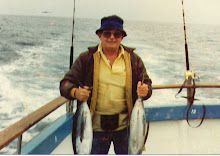The assortment and quantity of wildlife in Alma, Nebraska, certainly differs from what I was accustomed to in Duarte, California. Some are the same, though. What area of this country can say it contains no coyotes, raccoons or opossums? Not many, if any.
Each morning my oldest daughter (Eva) and I walk for three miles along a trail next to the Harlan County Reservoir. The trail meanders through some beautifully wooded areas and next to some typically Nebraskan farmland. Often we surprise a deer on or next to the trail and we get a good view of its rear end as it leaves us behind and heads for safety. While I am fascinated by them and their grace, Eva holds a grudge against them. She has a garden at her house and has had to build a fence around it to keep the deer from eating her tomatoes, lettuce, cucumbers, etc., before they have had a chance to produce the bounty of produce she counts on for cooking and canning.
One morning we were surprised to see a mama 'possum trudging through some grass while transporting her five or six little ones on her back. I can only assume that the marsupial's eyesight is not too good. We stood absolutely still watching her but if she saw us standing in plain sight, she gave no sign of it.
Rabbits abound. These are not the long eared jackrabbits (which are really hares) we see in California but cottontails, which are smaller. Each morning we find them on the trail and next to the trail. Some mornings we see more than ten or fifteen. They are prudently careful but they don't panic at the sight of us. Some of them wait until we are only two or three feet from them before they bound off into the woods or tall grass. I would imagine there are some well fed coyotes, foxes and owls in the area.
My daughter's yard and garden are home to at least one mama rabbit and her little ones. Nature is nature, and over a couple of weeks mama rabbit was down to one baby. It was small enough to get through the openings in the metal link fence and was stuffing itself daily on Eva's freshly sprouting vegetables. Eva's yard also hosts a bull snake (harmless to humans). One day she noticed that the snake had an unnatural bulge in its midsection and the baby rabbit was nowhere to be seen. Shortly thereafter, mama rabbit left for other hunting grounds.
I drive seven miles to the nearby town of Orleans once or twice a week, and as I drive between the ever present cornfields I see more animals. Yesterday, I came to a halt as a mama raccoon and four little ones came from the right side of the road and started for the other side. Once I had stopped, she looked up at the car, turned around in the middle of the road and headed back into the cornfield whence she came, followed of course by her troupe of little masked raccoons. Their hind legs are longer than the front, and with their ringed tails high in the air, they made for an odd looking parade as they disappeared single file into the field.
Last week I had the same experience on the same road with a mama wild turkey and her five or six little ones. At least they continued across the road. Wild turkeys are abundant here and are a staple for hunters when the season is on.
On another day, I saw a different looking critter start to cross the road then change its mind and head back for tall grass. Only when I got right up near it did I realize it was a badger. Yep, they're here, too.
One Nebraska inhabitant I am not likely to see (they are nocturnal) is the armadillo. I didn't realize they came this far north, so I did a little research and discovered they do exist here in the Husker State. I think armadillos are one of North America's most fascinating animals. They are digging machines and are known to dig a burrow faster than a foot a minute. The range of armadillos keeps spreading and animal scientists are not sure how far north they will ultimately go. Two hundred years ago, they were limited to South America, but now they are found as far north as Illinois. This is the nine banded armadillo, which seems to be the most adaptable of all the variations in this strange animal. With its limited ability to store body fat, it was believed it couldn't survive the winters in Kansas and Nebraska, but here it is and it seems to be thriving.
I have yet to see one of the state's porcupines, which are common, and if I do see one you can bet I will keep my distance.
Went fishing again this morning. The score now stands fish=300, me=0.
Thursday, July 26, 2007
Subscribe to:
Post Comments (Atom)




No comments:
Post a Comment